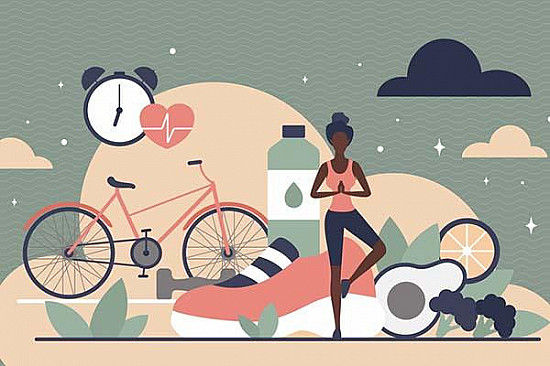Exercise and chronic prostatitis
By now, we’ve all heard about the value of exercise in maintaining good health. Literally hundreds of studies conducted over more than half a century demonstrate that regular exercise pares down your risk of developing some deadly problems, including heart disease, stroke, and certain types of cancer (colorectal cancer, for example). It also eases the toll of chronic ailments like high blood pressure, diabetes, and arthritis. What may come as a surprise is that regular physical activity may actually help prevent some prostate disorders and improve prostate health. For example, emerging scientific evidence suggests that engaging in a few hours of exercise a week may ease the symptoms of chronic prostatitis, also called chronic pelvic pain syndrome (CPPS).
| Note: Talk with your doctor before starting an exercise program. He or she can help you design a routine to meet your needs and make sure that you are exercising safely. |
Assessing the evidence
Chronic prostatitis is characterized by pain during urination, difficulty urinating, sexual dysfunction, anxiety, and depression. It can be prompted by an undetectable infectious agent or physical trauma that causes inflammation or nerve damage in the genitourinary area. Unfortunately, doctors can identify bacteria as the culprit in only about 5% to 10% of cases, meaning antibiotics are not an effective treatment in most men. While many other treatments have been tested, none have proved to have significant long-term benefits.
Wondering if exercise might alleviate symptoms when other treatments fail, Italian researchers randomly assigned 231 sedentary men with chronic prostatitis to one of two exercise programs for 18 weeks: aerobic exercise, which included brisk walking and strengthening exercises, or nonaerobic exercise, which included exercises such as leg lifts and sit-ups, as well as stretching. Each group exercised three times a week. (See “Research on exercise and chronic prostatitis,” below.)
At the start of the study and at six and 18 weeks, participants responded to questionnaires about their symptoms and quality of life. At the end of the trial, participants in both groups felt better, but those in the aerobic exercise group experienced significantly greater improvements in prostatitis pain, anxiety and depression, and quality of life.
Research on exercise and chronic prostatitisGiubilei G, Mondaini N, Minervini A, et al. Physical Activity of Men with Chronic Prostatitis/Chronic Pelvic Pain Syndrome Not Satisfied with Conventional Treatments — Could It Represent a Valid Option? The Physical Activity and Male Pelvic Pain Trial: A Double-Blind, Randomized Study. Journal of Urology 2007;177:159–65. PMID: 17162029. |
Reaping the benefits
So how much exercise should you do if you’re concerned about prostate health? What activities can you do? Do you have to take up jogging? Must you spend hours huffing and puffing on a treadmill at a gym to keep your prostate healthy?
There is no specific exercise program for men coping with chronic prostatitis. But a well-rounded exercise program that includes just half an hour of physical activity on all or most days of the week delivers solid health benefits. And you needn’t perform this activity all at once; you can break it up into three 10-minute segments. Aim for a moderate pace. A good guideline: you should be able to carry on a conversation — yes, short sentences are okay — while exercising. If you’re breathing too hard to talk comfortably, back off. When an activity becomes easy, boost the length of your workout or your speed. (For more on how hard to work, see “What about my heart rate?” below.)
If you want, you can jog or use the treadmill at the gym (see “Health club savvy,” below). But keep in mind that bicycling (see “Your bike seat and your health,” below), swimming, or even taking brisk walks around the block will do the trick. In fact, walking has been touted as a nearly perfect exercise because people of all ages and fitness levels can do it. Walking is also safe for nearly everyone. It doesn’t jar joints or raise the heart rate to a level that would be dangerous, even for someone who is not in good shape.
What about my heart rate?Many people have been taught to measure their pulse during an aerobic workout to see whether they’ve reached a target heart rate. To figure your maximum heart rate, subtract your age from 220. Multiply the result by 50% for the low end of your target range or by 75% for the high end. There are drawbacks to this technique, however. Few people take their pulse accurately enough to make the effort worthwhile. And since your pulse drops rapidly when you’re not exercising, measuring it after you’ve stopped won’t say much about your true level of exertion. Simply paying attention to your body’s signals, such as how hard you are breathing, will tell you whether you can work harder or should slow down. |
Health club savvyWhile you don’t need to join a health club to exercise, membership does have some advantages. You’ll have access to a wide variety of equipment and exercise classes, so it’s easy to change your routine and avoid boredom. Personal trainers can help you devise a routine and teach you how to use the equipment properly. And many people find that joining a gym motivates them to exercise frequently because they want to get their money’s worth. On the other hand, memberships are often expensive, though some insurance companies will reimburse part or all of the cost. In addition, some gyms are so crowded that you may not get into the classes you want, or you may have to wait in line to use a piece of equipment. Before joining, tour a gym at the times you’re likely to use it so you can see what the atmosphere will be like. Make sure the location and hours work with your schedule. If you want to work regularly with a trainer, ask about any additional fees and about the trainer’s qualifications. Look for trainers who have been certified by a professional organization, such as the American College of Sports Medicine. |
Your bike seat and your healthA sustained ride on a narrow bicycle seat compresses the nerves in the perineum, the area between the scrotum and the anus, leading to numbness in the penis. Rarely, impotence occurs. The problem can last from a week to a month after a lengthy bike ride. Taking the following precautions can help you avoid these problems:
|
No matter what activity you choose (for ideas, see “Pick your favorite,” below), avoid sporadic bouts of high-intensity activity. For one thing, the health benefits of exercise depend on the total amount of exercise rather than its intensity. But more importantly, higher-intensity activity raises your chances for muscle or joint injury and for sudden death as a result of heart rhythm disturbances, especially if you’re a “weekend warrior” or you haven’t had a medical check-up to clear you for intense exertion.
Pick your favoriteDozens of activities “count” as aerobic exercise. Choose one — or even several — that you enjoy. You’ll be more likely to stick with exercise if you make the routine fun. Consider activities like these:
|
Before you start a session of aerobic exercise, include five to 10 minutes of light stretching and low-intensity movement to warm up; this is crucial to avoid injury. Also work in a cool-down period of equal length.
In addition to aerobic activities like walking, a well-rounded exercise program includes strength training, flexibility training (stretching), and balance exercises; each benefits your body in a different way. Strength training builds your muscles and bones and improves your body’s ratio of lean muscle mass to fat. Flexibility training keeps your muscles stretched and your joints limber, and may help prevent injury. Balance exercises ward off falls that can prompt injuries.
Keeping exercise safe
As Harvard’s Dr. Harvey Simon writes in his book The No Sweat Exercise Plan, “The greatest hazard of exercise is not doing it. Far more people are harmed by the lack of exercise than by its excess.” Although the benefits of regular physical activity far outweigh the risks, there are risks, which can range from minor inconveniences to life-threatening situations.
Perhaps the most common risks associated with exercise are muscle and joint problems. Strains, tears, or fractures can be caused by quick movements, such as lunging for a tennis ball. Stiffness, soreness of joints and muscles, and inflammation of tendons and ligaments may be brought on by training too hard or too often, using improper technique or poor equipment (such as worn-out exercise shoes), increasing your activity level too quickly, or not dropping back to a lower level of exercise after a period of inactivity.
By far the most frightening risk associated with exercise is sudden death. Sedentary people who abruptly embark upon vigorous exercise can increase their chances of dying from a heart attack or an arrhythmia, a change in the heart’s rhythm. But it’s important to keep this in perspective. The absolute risk of sudden death during any episode of exercise is minuscule: one in every 1.51 million exercise sessions. It’s equally important to remember that the risk of sudden death discussed here is associated with vigorous exercise. If you work out at a moderate level, your risk is negligible.
To make sure that your exercise routine is as safe and enjoyable as possible, take these simple precautions:
- Talk to your doctor before beginning an exercise program, especially if you have a health problem. He or she can help you determine your limitations and develop a routine that’s appropriate for your fitness level.
- Warm up and cool down properly.
- Drink plenty of fluids.
- Watch for signs of overheating — headache, dizziness, nausea, fainting, cramps, or palpitations — especially in hot, humid weather. If possible, schedule exercise sessions in the early morning or late evening, when temperatures tend to be lower.
- Don’t exercise if you are ill. Resume exercising after you recover, but give yourself time to work back up to your usual level.
- Let injuries heal. That doesn’t mean you need to give up exercise, though. For example, if you’ve sprained your ankle while jogging, try swimming or other activities that use your arms and keep you off your feet.
- Dress in loose, comfortable clothing that’s appropriate for the weather.
- Pay attention to your surroundings. If you walk or jog, for example, always face the traffic. If you bike, ride with the traffic; remember to wear a helmet and obey the rules of the road. Stick to well-lit streets. Consider bringing a cell phone.
Most importantly, listen to your body. Don’t overexert yourself. Cut back if you can’t finish an exercise session, can’t carry on a conversation while exercising, or feel faint or suffer aches and pains in your joints after exercising. Stop your activity and see a doctor right away if you experience burning, tightness, or a feeling of fullness in the chest or upper body; faintness or loss of consciousness; wheezing or shortness of breath that takes more than a few minutes to go away; or pain in the bones or joints.
Admittedly, highlighting the risks of exercise and suggesting various precautions might make you think that getting a daily dose of physical activity is risky business or an utter chore, but it’s not. It can actually be great fun. And it can help keep you — and your prostate — in top shape.
Originally published Oct. 1, 2008; last reviewed April 26, 2011.
About the Author
Disclaimer:
As a service to our readers, Harvard Health Publishing provides access to our library of archived content. Please note the date of last review or update on all articles.
No content on this site, regardless of date, should ever be used as a substitute for direct medical advice from your doctor or other qualified clinician.















